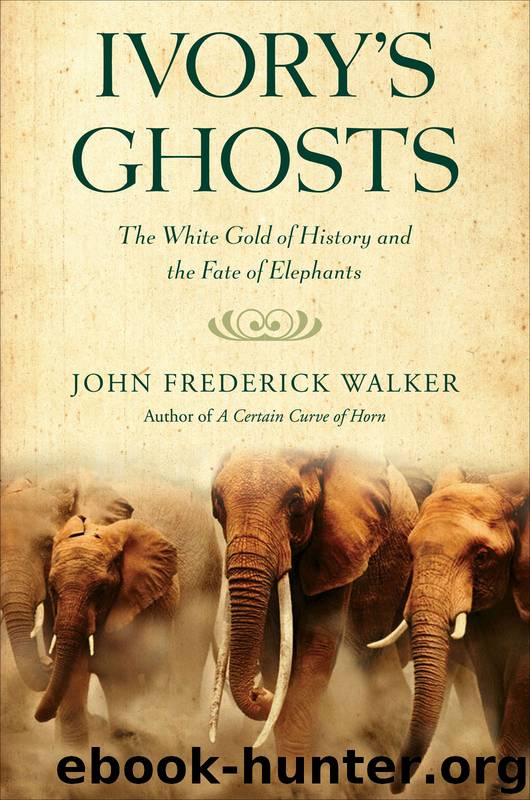Ivory's Ghosts by John Frederick Walker

Author:John Frederick Walker
Language: eng
Format: epub
Publisher: Grove/Atlantic, Inc.
Published: 2009-03-13T16:00:00+00:00
“MOMBASA IS SLOWLY taking over the role of the world’s main ivory centre from London,” proclaimed the Mombasa Times in January of 1961. During 1960–61 virtually all East African ivory, some seventy-five tons, passed through the port of Mombasa, as did one hundred tons from the Congo.
In 1970 the scene on auction day at the Mombasa Ivory Rooms didn’t look much different than it did when E. D. Moore was purchasing ivory. “The unprepossessing warehouse close to the waterfront was thronged with a varied collection of more or less shabbily dressed men, alike only in their wearing of that completely disinterested look affected by all professional dealers,” Wilson and Ayerst wrote of their visit there. “Swahilis in robes and turbans, Indians in long jackets and skullcaps, here and there an occasional European buyer—all wandered with catalogues and pencils from pile to pile of carefully graded tusks and ‘pieces.’” Together, the dealers paid more than £100,000 for the day’s lots in heated bidding, especially over two magnificent pairs of hundred-pound tusks; nothing remained unsold, they wrote, including dirty cracked ivory and a handful of hippo teeth—“such is the demand for African ivory throughout Asia.”
Wilson and Ayerst found that about a quarter of the forty thousand pounds of ivory in the sale was confiscated from poachers, another quarter came from game department culling programs, and the rest came from elephants shot on license by hunters and “pick-up ivory” recovered from elephants that had died of natural causes. Under East African colonial rule, Mombasa had become the preeminent center of the continent’s ivory trade; following independence in the early 1960s, most countries made their own export arrangements—Tanzania was sending virtually all its ivory to the People’s Republic of China. Nonetheless, ivory in the sale room had came from the Congo, Uganda, Sudan, and Ethiopia as well as Kenya. It stayed in the government warehouse for several weeks after purchase while the agents resold the ivory by cable, telex, and telephone, almost all of it to China, Hong Kong, India, and Singapore, with small parcels going to the Persian Gulf and Europe.
Ivory’s value had been remarkably stable for decades before it rose in the 1920s and then fell sharply during the Depression. Afterward, it recovered its previous levels and started climbing steadily once again. Following World War II, the demand for ivory from newly prosperous Asian countries pushed prices to historic highs and, from the 1970s on, to dizzying new heights.
In the 1970s the Asian market was led by Hong Kong and Japan—together, they were importing three-quarters of the world’s annual ivory supply. Hong Kong reexported raw ivory to other Asian countries and, like China, produced endless ivory knickknacks for the international curio business, even sending some of its worked ivory back to Africa to be sold to tourists as African carvings. Hong Kong had three thousand craftsmen, who by then had adopted electric tools, especially handheld drills, to carve ivory, vastly decreasing the time required to turn out, say, a Cantonese concentric ball.
Download
This site does not store any files on its server. We only index and link to content provided by other sites. Please contact the content providers to delete copyright contents if any and email us, we'll remove relevant links or contents immediately.
Sapiens: A Brief History of Humankind by Yuval Noah Harari(13107)
The Tidewater Tales by John Barth(12045)
Do No Harm Stories of Life, Death and Brain Surgery by Henry Marsh(6348)
Mastermind: How to Think Like Sherlock Holmes by Maria Konnikova(6269)
The Thirst by Nesbo Jo(5813)
Why We Sleep: Unlocking the Power of Sleep and Dreams by Matthew Walker(5676)
Sapiens by Yuval Noah Harari(4573)
Life 3.0: Being Human in the Age of Artificial Intelligence by Tegmark Max(4534)
The Longevity Diet by Valter Longo(4461)
The Rules Do Not Apply by Ariel Levy(3927)
The Body: A Guide for Occupants by Bill Bryson(3849)
The Immortal Life of Henrietta Lacks by Rebecca Skloot(3839)
Why We Sleep by Matthew Walker(3794)
Animal Frequency by Melissa Alvarez(3769)
Yoga Anatomy by Kaminoff Leslie(3724)
Barron's AP Biology by Goldberg M.S. Deborah T(3642)
The Hacking of the American Mind by Robert H. Lustig(3594)
All Creatures Great and Small by James Herriot(3535)
Yoga Anatomy by Leslie Kaminoff & Amy Matthews(3418)
